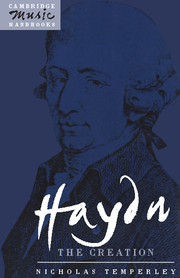Book contents
1 - Background
Published online by Cambridge University Press: 05 June 2012
Summary
Haydn completed his greatest work, Die Schöpfung/The Creation, in 1797, when he was sixty-five years old. It is generally seen as the culmination of his career, although his earlier achievements were centred not in oratorio but in music for orchestra, strings and keyboard, and to a lesser extent in operas, masses and secular songs.
The immediate occasion for the work was a commissioned private performance in Vienna, to be followed by public performances in the same city. Yet The Creation bears little affinity to the Italian or German oratorios that had been current in Vienna in Haydn's lifetime, nor does it have any close precedent in his earlier works. Its true ancestor is the English oratorio of Handel, a form which Haydn absorbed and remoulded in the light of his long and unequalled experience as a composer of symphonies and operas.
Oratorio, in the eighteenth century, was closer to the theatre than to the church. The libretto was usually in verse, and was taken from a biblical or other religious story. It provided for arias, recitatives, choruses and an opening sinfonia of the same general character as those found in Italian opera seria, and the vocal and instrumental forces were also similar, although there were usually more choruses than in an opera.
- Type
- Chapter
- Information
- Haydn: The Creation , pp. 1 - 8Publisher: Cambridge University PressPrint publication year: 1991

